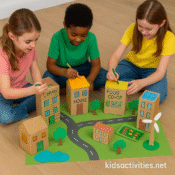
Cultural Exchange Night – Exploring Global Traditions Through Play
The Problem:
Many children know more about cartoon characters than they do about the cultures of their neighbours and classmates. Families often struggle to introduce global traditions in a way that’s meaningful, inclusive, and fun.
Why It Matters:
Cultural literacy builds empathy, curiosity, and a sense of global citizenship. A family “cultural night” invites children to explore, ask questions, and celebrate the richness of human traditions.
How to Host a Cultural Exchange Night
1. Pick a Region or Theme
Choose a continent, country, or cultural theme (like festivals, food, or clothing). Rotate weekly to cover different areas.
2. Research Together
Find books, short videos, or recipes. Let your child lead the research with guidance.
3. Prepare a Cultural Dinner
Cook a dish from the chosen culture. Set the table accordingly, play traditional music, and read facts while eating.
4. Hands-On Crafts or Games
- Make Rangoli patterns with coloured rice (India)
- Build paper lanterns (China)
- Create African kente cloth patterns with paper strips
5. Storytelling Time
Read folktales from the region. Act them out, draw characters, or write your own ending.
6. Global Guest Call
If possible, video call a friend or family member from another background to share something about their culture.
Educational Benefits
- Geography & Language: Understanding world maps, new alphabets or phrases
- Arts Integration: Craft, music, dance, food preparation
- Civic Awareness: Respecting diverse customs and values
Downloadables
- Culture Night Planning Template
- Printable Passport with Stickers
- World Culture Craft Card Set
Parting Words
You don’t need to fly around the world to expose your kids to global traditions. Start with one night, one meal, one story. The goal isn’t perfection—it’s participation.
Invite neighbours and keep a scrapbook of your cultural nights—it can become a family tradition over time.




